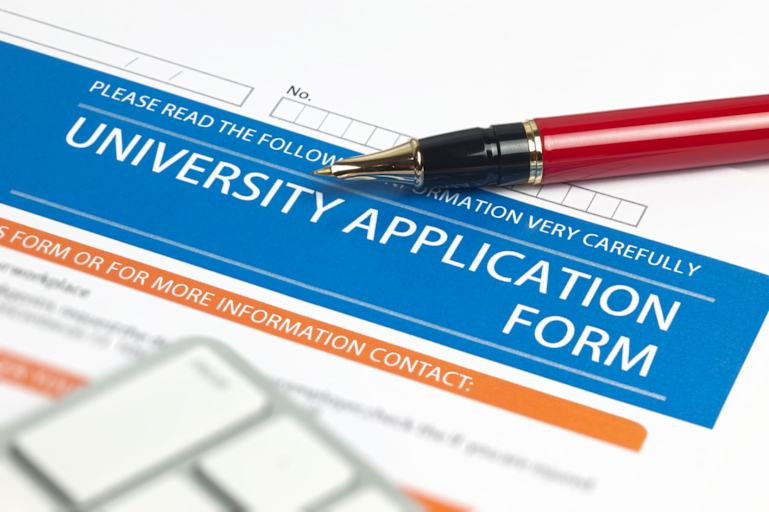How Many Colleges Should You Apply To?

- Prospective students apply to around six colleges on average.
- Students should apply to a balanced mix of reach, target, and safety schools.
- Only apply to schools you could see yourself attending.
- The Common App, early decision, and fee waivers can make the application process easier.
By February 2025, the Common Application had already processed over 8 million applications for the 2024-25 cycle. There were around 1.3 million unique applicants, indicating that each student submitted applications to around six schools.
As a general rule of thumb, some admissions experts recommend submitting applications to 5-12 schools.
In reality, though, there’s no one-size-fits-all answer. How many colleges you should apply to depends on your preferences, admission odds, and financial situation. A college counselor can help determine the number of college applications you should submit.
Key Factors to Consider When Applying to Colleges
There’s no limit on the number of college applications you can submit. In 2018, North Carolina high school senior Jasmine Harrison submitted applications to 115 colleges — and received admission offers from 113 of them.
But there’s a reason most students don’t submit 100 applications. They simply can’t complete that many applications or afford the application fees. Additionally, it would be difficult to research so many schools.
Still, you also should avoid applying to too few colleges. In general, applying to a minimum of five schools is a good idea. Submitting more applications increases the likelihood of an acceptance and the odds of receiving financial aid offers.
Before putting colleges on your list, consider key factors like your budget, financial aid opportunities, and personal preferences. Every school on your list should be a place you could actually see yourself attending.
Learn More About Empowerly’s College Admissions Counseling
How to Narrow Down Your List of Colleges
College applicants have roughly 4,000 degree-granting postsecondary institutions to choose from in the U.S. alone. So what’s the best way to narrow down your list of prospective schools?
Many applicants start by putting together a list of their top picks and looking for gaps. If your list only contains Ivy League schools, for example, you should add other colleges that offer a higher chance of acceptance. On the other hand, if your list only contains schools that almost certainly will admit you, it’s a good idea to add some reach schools.
Think about your strategy as if you were Goldilocks. You want a handful of target schools that offer a “just right” fit for your grades, your SAT/ACT scores, and other admissions materials, but you also want to add safety and reach schools to your list.
What Are Safety, Target, and Reach Schools?
Choosing schools based on their selectivity can be helpful, and applying to a good mix of safety, target, and reach schools can help ensure you’re covering all your bases.
What Is a Reach School?
A reach school is any college where an applicant has a lower chance of getting in. The schools that count as a reach depend on the applicant’s record. Check the college’s statistics on admitted students to determine whether it’s a reach school.
Most schools post the median, 25th percentile, and 75th percentile GPAs and test scores for their first-year classes on their websites. If you fall below the median, that school would qualify as a reach school for you.
Reach schools often include highly selective colleges that admit a small number of applicants.
Schools that report acceptance rates of 10% or less — such as Harvard, Stanford, Princeton, and Duke — are reach schools for nearly all applicants. Even students with high grades and test scores may be turned down by their reach schools.
A smaller likelihood of admission means you’ll need a great application. College counselors can advise you on how to best tailor your application to your reach schools.
What Is a Target School?
Target schools are ones where you have a solid chance of receiving an application letter.
If your GPA and test scores fall between the 50th and 75th percentiles for admitted students, you can consider that institution a target school.
Nevertheless, don’t apply to target schools simply because you have a higher chance of getting in. Your target schools should be colleges that are your personal best fit — they need to match your budget, academic goals, and overall college plans.
What Is a Safety School?
A safety school offers applicants a strong chance of getting accepted. However, the definition of a safety school varies depending on the applicant.
If your GPA and test scores exceed admitted students’ 75th percentile GPA and standardized test scores, you may consider that institution a safety school. One common myth claims that safety schools are academically or socially inferior.
The truth is that the majority of colleges admit most applicants, according to an American Enterprise Institute report. And regionally accredited schools with less selective admission requirements still award high-quality degrees.
Many students add at least one in-state public university to their list. These schools can offer significant tuition discounts to — and often prefer — in-state applicants.
How Many Reach, Target, and Safety Schools Should You Apply to?
How you spread out your applications among school types depends on your ambition and your desired level of security. College Board recommends applying to 5-8 schools, with approximately 50% of those applications dedicated to your target schools.
Use the remaining 2-4 applications for your safety and reach schools. If you feel confident about getting into your one safety school, you might take more of a risk and apply to more reach schools.
Is It OK to Apply to Only One College?
In general, prospective students should apply to multiple schools to increase their odds of getting accepted. However, there are cases when applying to just one school makes sense. For example, college applications can be costly, and a single application may be your only option.
Other possible scenarios include students who can only attend one school or program, possibly limited by location or program offerings. In these situations, additional applications would be rather useless. Despite the suggestions, the ideal number of applications depends entirely on you and your specific needs and wants.
6 Strategies for Streamlining the College Application Process
Applying to multiple colleges takes time and money. Fortunately, there are strategies applicants can use to help streamline the college application process, save money, and potentially add schools to their list.
1 | Use the Common App
Over 950 colleges accept the Common Application. With a single application, you can apply to multiple schools without having to fill out a dozen or more individual applications or complete specialized essays. The Common App helps students save time on their applications.
2 | Apply for Application Fee Waivers
Many colleges waive the application fee for qualifying students. For example, students who received an SAT fee waiver can receive college application fee waivers at participating colleges. The same applies to students who qualify for Pell Grants.
3 | Reuse or Recycle Your College Essays
Applying to 10 schools might mean writing 10 college application essays. Because many schools use similar prompts, applicants can often reuse or recycle their essays.
That said, proceed with caution. You want to customize each essay so that it fully answers the prompt. If it’s obvious to admissions advisors that you’re recycling an old essay, it could hurt your application.
4 | Apply Early Decision or Early Action
Many schools accept early applications. These have earlier application deadlines than regular decision but provide you with a decision sooner, usually by December. Applying early decision or early action can increase your chances of admission. Additionally, if you’re accepted, you might only have to complete a single college application.
5 | Talk With a College Counselor
A college counselor can offer advice on which colleges might be a target school or a reach school for you. Counselors also have great tips for completing applications more efficiently, finding scholarships, choosing extracurriculars, writing essays, and preparing for tests.
5 | Keep Track of Your Applications
Completing college applications can be time-consuming and stressful. Creating a calendar to track deadlines and manage steps like requesting recommendation letters makes it easier to stay on top of applications.
Frequently Asked Questions About How Many Colleges You Should Apply To
No. Applying to 12 schools can be perfectly suitable for many prospective students. However, if you choose to submit many applications, get an early start.
Applications take time to complete. If you try to do too many, you run a greater risk of lowering the quality of all your applications. Be sure to give yourself enough time to gather all the necessary materials and submit the best applications you can put together.
Explore More College Resources

160 Colleges With No Application Fee
Find U.S. colleges with no application fee and learn more about how to save during the college application process.

by Jordan Stewart-Rozema, Ph.D.
Updated July 9, 2025



